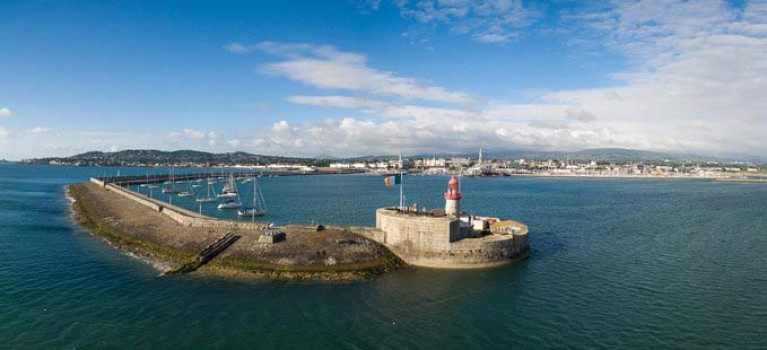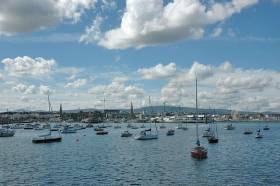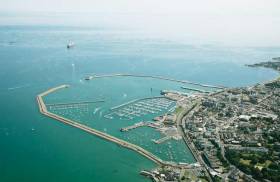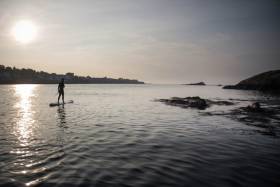Displaying items by tag: Dun Laoghaire Harbour
Watersport School To Open New Hub At Dun Laoghaire’s Coal Harbour
Irish watersport school BigStyle has announced the development of a new hub for stand-up paddleboarding at Dun Laoghaire’s Coal Harbour.
The news comes just months after the business, which has expanded as far afield as East Africa, mooted plans for a more permanent base in Dun Laoghaire, where one of its founders grew up.
The new facility will be constructed from renovated shipping containers, in a similar fashion to the Irish Sailing Performance HQ opened in the harbour last year.
BigStyle says its new space will comprise ‘chill-out areas’, changing rooms, clothes and equipment storage, direct access to the water “and a whole lot of charm”, along the lines of its own Atlantic Lodge for the surfing community in Co Mayo.

“Above all we want to be as environmentally conscious as possible — the building will be totally off grid with solar panels, a water harvester, 12v power and as little single use plastic as possible,” the business says.
While the main purpose of the space will be the SUP school, BigStyle also plans to have a surf shop and a simple coffee shop, and will also make room for the Clean Coasts initiative to spread awareness, launch clean-ups and hold various events.
The space is currently scheduled to open just over three months from now, at the beginning of May, “and we’re confident that this will help reinvigorate an often overlooked area of the harbour”, the company adds.
Dun Laoghaire Harbour Master Issues First Notice to Mariners of 2020
Dun Laoghaire Harbour Master Simon Coate has issued the first notice to Mariners of 2020 for the Dublin Bay harbour as a reminder which notices remain in force.
- No. 7 (2010) - Discontinuation of Fog Signal
- No. 6 (2013) - Disestablishment of ‘Traffic Operating Lights’
- No. 7 (2014) – Marina East & West Breakwaters – Alteration of Character, Synchronisation of Lights and
Installation of Topmarks - No. 8 (2014) – Permanent Withdrawal of Dun Laoghaire Buoys Nos 1 & 2
- No. 6 (2016) – No 1 Berth Permanently Closed to Shipping
- No. 8 (2016) – No 3 Berth Permanently Closed to Shipping
- No. 9 (2017) – St Michael’s Pier NE Pile Change to Light Character
- No. 5 (2018) - Use of Unmanned Aerial Vehicles (UAVs) / Drones
- No. 9 (2019) – Relocation of Cruise Ship Tender Pontoon
All other Dun Laoghaire Notices to Mariners are automatically cancelled at 23:59 hours on the 31st December 2019. At that time 2020 Notices to Mariners will come to in to force until specifically cancelled or until 23:59 hours on the 31st December 2020.
Dun Laoghaire is undoubtedly a harbour which merits study. So much so, in fact, that as of this week, the qualifications for detailed study of the magnificent artificial harbour and the remarkable town beside it have been quantified - to the cool tune of €600,000 in all -for research and report on development.
It’s a tidy sum. Yet it’s real enough. Back in September, we referred to the two analyses which Dun Laoghaire Rathdown County Council had put out to tender for €100,000 each, one for research and conclusions on how best to develop the harbour/township waterfront area, and the other – for an identical amount – for recommendations on putting new life into the rundown parts of the town itself.
The harbour and the coastal location being Dun Laoghaire’s greatest assets, with the harbour the township’s ultimate reason for existence despite the fact that the original harbour planners didn’t take the creation of a township into account, we’d have thought the two projects were the two sides of the same coin. But even with them being separate contracts, the fact is that by the end of 2019, €200,000 had set aside for these specific expenditures, and the research work was underway.
But as of this week, those two smaller studies have been put in the shade by the very clear announcement by the Department of Transport, Tourism & and Sport that a feasibility study - costed at €400,000 - will be Government-commissioned to progress the €8 million National Watersports Campus proposed for the harbour by Dun Laoghaire Rathdown County Council, working in concert with Irish Sailing and the Irish Underwater Council, and supported specifically by Triathlon Ireland, Rowing Ireland, Irish National Sailing & Powerboat School and Canoeing Ireland, with additional support from nearly 40 other organisations – including the yacht clubs - which use the harbour and its environs in one way or another.
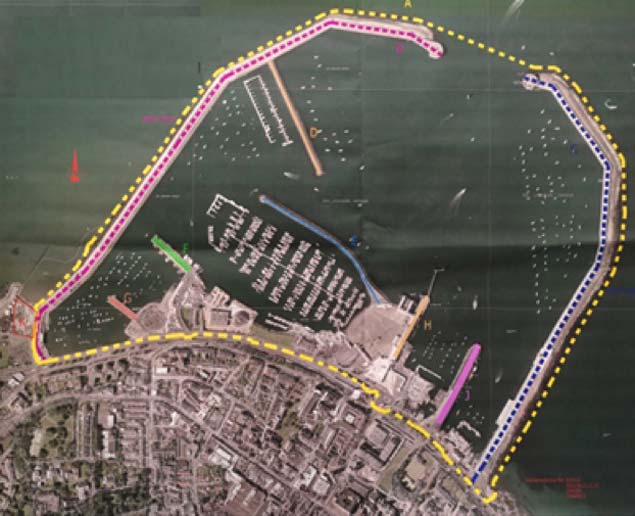 The proposed National Watersports Campus is envisaged as being the entire area within the yellow-dotted line, including all the waterfront shoreside area to seaward of the railway line.
The proposed National Watersports Campus is envisaged as being the entire area within the yellow-dotted line, including all the waterfront shoreside area to seaward of the railway line.
Getting so many different organisations and interests to pull together and work in support of what is ultimately a Local Government initiative has been a monumental task of patience and persistence, and painstaking attention to detail. For in the end, the fact that the Dun Laoghaire proposal was one of the few that won out, in what was effectively a national competition involving many possible projects applying to the Large Scale Sports Infrastructure Fund (LSSIF), was a matter of covering every angle from the effect on the local economy – particularly employment – to the environmental impact, while working in with the fact that anything which makes participant sport more accessible and welcoming chimes well with national policy on improving people’s health and sense of wellbeing.
The proposed National Watersports Campus will also play a key role in bringing much more life to the Dun Laoghaire waterfront, as it would be expected to function on a seven days a week basis, certainly from March to November, and probably year-round. And once you start getting such activity being the norm at one of the most visible parts of the harbour (for the already busy Irish National Sailing School is somewhat hidden away in the inner recesses of the Coal Harbour to the westward) the perceptions of the harbour as a place only of seasonal activity and vitality will change, and the sometimes weak interaction between town and sea will become more dynamic.
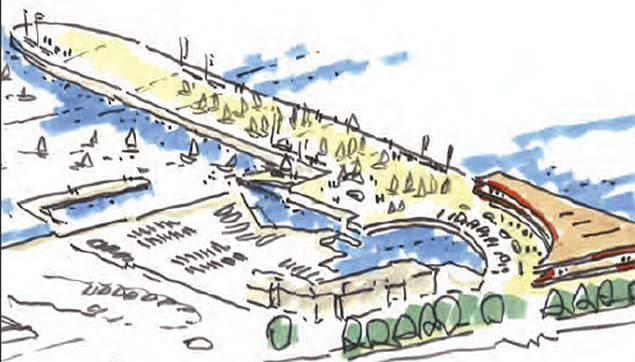 A preliminary artist’s sketch of the possible layout for the National Watersports Centre at the south end of the Carlisle Pier, with a large-scale all-tides slipway on the pier’s west side
A preliminary artist’s sketch of the possible layout for the National Watersports Centre at the south end of the Carlisle Pier, with a large-scale all-tides slipway on the pier’s west side
But all these things would not have become possible as of Monday this week had it not been for a long period of what might be called good work by stealth by a visionary group. Good work by stealth is perhaps the only truly good work, except that “stealth” suggests subterfuge, whereas this has all been about many hours and days – years even – of discussion, planning and quiet meetings and then yet more meetings, always through official channels but without making a song and dance about it.
From time to time here in Afloat.ie we’ve alluded to the proposed developments gradually taking shape, but have tried to respect the fact that those involved are doers rather than talkers, except when talk is needed to progress the project. Thus we’re in the odd position of mentioning all the main organisations which are involved without mentioning any single person’s name, and that is the way that those who got this particular ball rolling would like it, for until the official announcement was finally made, nothing was absolutely certain.
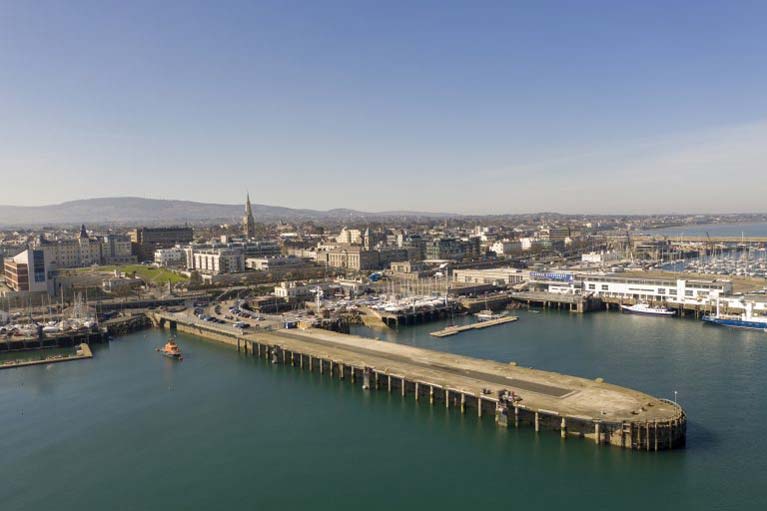 Carlisle Pier is in a sorry state, its outer end in the heart of the harbour inaccessible, and the inner end utilised as a car park. Photo courtesy Barrow Coakley/Simon Coate
Carlisle Pier is in a sorry state, its outer end in the heart of the harbour inaccessible, and the inner end utilised as a car park. Photo courtesy Barrow Coakley/Simon Coate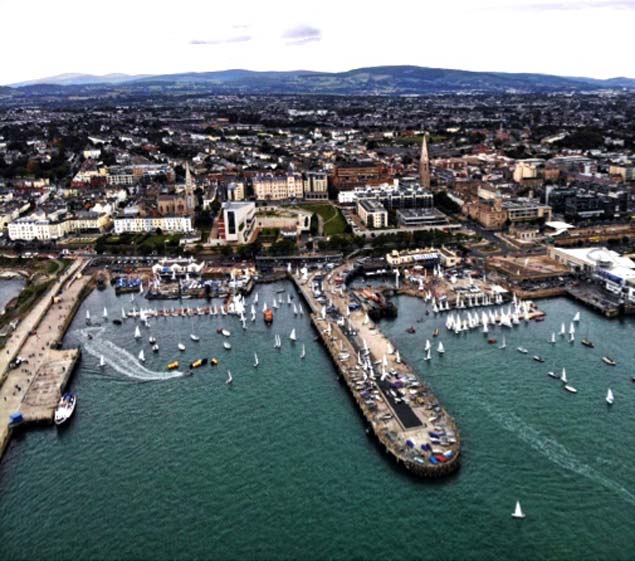 Carlisle Pier brought temporarily to life for the Laser World Masters, September 2018. Planning for the new National Watersports Centre was able to draw on experienced gained from this event in which more than 300 boats took part
Carlisle Pier brought temporarily to life for the Laser World Masters, September 2018. Planning for the new National Watersports Centre was able to draw on experienced gained from this event in which more than 300 boats took part
Maybe the sudden imminence of a General Election had something to do with this week’s surprise revelation of good news. Whatever, it certainly brightened up a Monday morning in January to learn that we were having one of those rare experiences when boat users of all kinds - and harbour users of every sort in Dun Laoghaire - seemed to be on the right side of politics, and of history too.
For talk of “history” is not over-stating it. The final shape of Dun Laoghaire’s extraordinary artificial harbour – so monumental that people think of it as a natural feature of Dublin Bay – was not finalised until the 1820s, even though construction had been started in 1817. But once it had been finalised, that was it – the outer limits of the great harbour had been set, and have remained the same ever since.
 Set in stone. Any plans for modern facilities in Dun Laoghaire Harbour have to take account of the fact that the basic outer shape was unchangeably set 200 years ago. Photo Peter Barrow
Set in stone. Any plans for modern facilities in Dun Laoghaire Harbour have to take account of the fact that the basic outer shape was unchangeably set 200 years ago. Photo Peter Barrow
But within, there has been scope for development, and it has not always had happy results. The weakened state of the Irish economy in the 1950s meant that some cheap ad hoc arrangements had to be put in place to accommodate the growing size of cross-channel ferries. And as the ferries were the harbour’s main source of income, their needs became paramount, leading to the construction of the massive yet decidedly incongruous Ferry Terminal on the extensive St Michael’s Wharf site in the prime site in the middle of the waterfront, dwarfing everything else.
So too did the huge HSS ferries which it served. Yet while the ferries and the terminal may have grown, the narrow winding roads ashore stayed the same, with the increasing size of juggernaut trucks which the ferries brought in leading to traffic congestion and pollution. “Dun Lorry No Thanks” became the catch-phrase of early environmentalists in the late 1990s, yet it was harsh economics as much as environmental concerns which led to the final ferry sailing in 2015.
This meant that the Dun Laoghaire waterfront – where every inch of space should be regarded as valuable with potential positive uses – now had two former ferry terminals of substantial area in Carlisle Pier and St Michael’s Wharf, locations which were basically dead spaces, even if their quaysides provided berths for the occasional ship and large yachts.
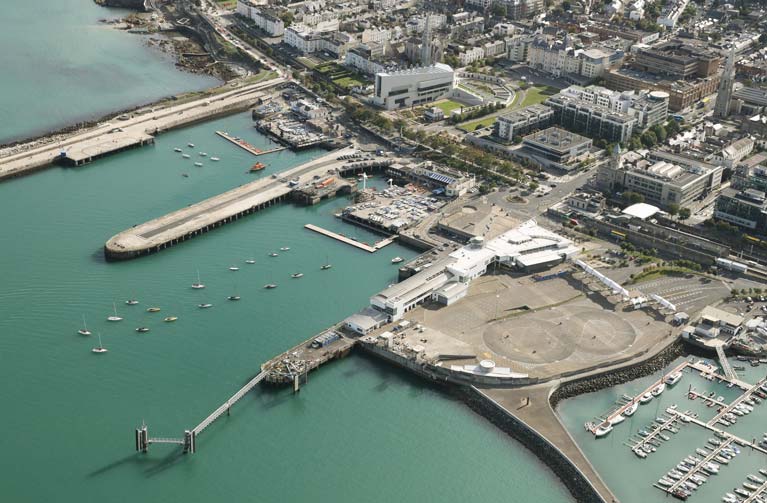 The eastern part of the Dun Laoghaire waterfront is blighted by the “dead spaces” of former ferry terminals at St Michael’s Wharf (foreground) and Carlisle Pier beyond.
The eastern part of the Dun Laoghaire waterfront is blighted by the “dead spaces” of former ferry terminals at St Michael’s Wharf (foreground) and Carlisle Pier beyond.
The utter lifelessness of these spaces has been emphasized by the fact that they are set between compact areas of intense maritime activity. To the eastward of Carlisle Pier is the busy National Yacht Club and the Dun Laoghaire RNLI base. Between Carlisle and St Michael’s, the Royal St George YC clubhouse with its forecourt/pontoons complex buzzes with life. Westward of the St Michael’s desert, the Marina and the Royal Irish YC snugly within it offer one of the best boat-berthing prospects in Europe.
Westward of the RIYC is the brief but welcome and revitalising waterfront of the Green, a very precious space. Beyond that, there is the Irish Lights HQ, and within it Irish Sailing’s Performance Group’s base – a temporary but vital facility which apparently will find a permanent home with the new National Watersports Centre.
Furthest west of all is the Coal Harbour, the Inner Harbour - call it what you will, and some would like to see it become more of a Heritage Harbour within the main harbour. But at the moment it’s an area where MGM Boats, St Michael’s Rowing Club, the Irish National Sailing School, Dun Laoghaire Motor Yacht Club and other organisations are making visionary and successful use of spaces which the original designers of the harbour left behind as by-products of their very fixed grand design two hundred years ago.
 A welcome focus of vitality – the well-maintained National YC is the most easterly of Dun Laoghaire’s waterfront yacht clubs and is celebrating its 150th anniversary in 2020
A welcome focus of vitality – the well-maintained National YC is the most easterly of Dun Laoghaire’s waterfront yacht clubs and is celebrating its 150th anniversary in 2020
Now, with the Council itself taking over the harbour and the harbour offices being re-located into County Hall, a new spirit of shared purpose has been gradually building as people recover from the prospect of the harbour being forced into domination by polluting cruise-liner berths in pursuit of what seemed like easy money and very questionable benefits. At last, there is a real sense of people, groups and organisations pulling together in order to see how best this extraordinary asset can be maximised for everyone’s benefit in many ways, with a healthy environment a top priority while at the same time retaining the harbour’s unique character.
It’s surely not overstating the case to suggest that the continuing success of the biennial Volvo Dun Laoghaire Regatta since its inception in 2005 has played a key role in developing this spirit of co-operation. It may seem absurd nowadays to think that it all seemed very novel at the time, but in those days the clubs all did things their own way, they relied on Dublin Bay Sailing Club to co-ordinate their weekly racing programme, and every year each club gave expression to its individuality with its own standalone regatta.
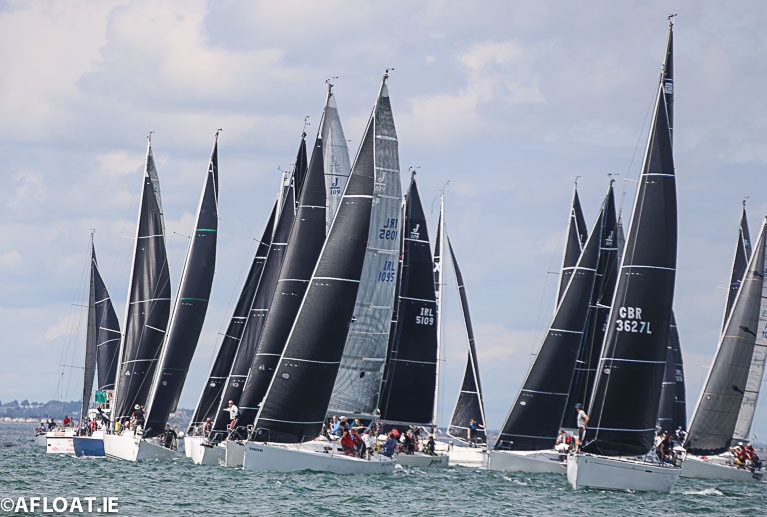 Volvo Dun Laoghaire Regatta in Dublin Bay. For fifteen years, this successful biennial event, the outcome of combined effort, has contributed greatly to the growing readiness of different organisations and the Council to work together in developing the harbour’s potential. Photo: Afloat.ie/David O’Brien
Volvo Dun Laoghaire Regatta in Dublin Bay. For fifteen years, this successful biennial event, the outcome of combined effort, has contributed greatly to the growing readiness of different organisations and the Council to work together in developing the harbour’s potential. Photo: Afloat.ie/David O’Brien
Certainly, there’d been attempts at regatta weeks in times past, but they’d always had the flavour of being one-offs. What was needed was a shared inter-club organisation which was in it for the long haul, and that came into being fifteen years ago, and has been going from strength to strength ever since, with the Council increasingly involved.
Then there was the shared emotion when Annalise Murphy of the National Yacht Club came home with her Olympic Silver Medal from Rio in August 2016. An Olympic medal is an Olympic medal regardless of whether or not one understands the ins and outs of the sport involved, and the magic day and night of Annalise’s return played its part in the slow process of changing perceptions of the relationship between town and harbour.
Yet if anything that changing perception emphasised the harbour’s general lack of convenient accessibility. At its most basic level, the prime location for simply viewing in-harbour activity would be from an observation area on the seaward side of the St Michael’s Wharf former ferry terminal and marshalling yard area. But it’s completely a no-go area.
 The conquering hero – Annalise Murphy returns to Dun Laoghaire with her Olympic Medal in 2016
The conquering hero – Annalise Murphy returns to Dun Laoghaire with her Olympic Medal in 2016
So too is the outer end of Carisle Pier. Certainly, you can stroll down the East Pier if you want to see the in-harbour activity, and there are reportedly 1.25 millions such strolls every year, though the majority are probably regular repeats. But for land-bound observers, there’s nothing to match being on the end of a pier within a busy harbour at a time of maximum activity afloat, and the fact that the end of Carlisle Pier is currently deemed unsafe is too typical of the way things had been going.
As for the inner sound section of Carlisle Pier’s use as a car park, it was convenient, it generates an income stream, but harbours are meant at the very least to be boat parks, not car parks, and in the case of Dun Laoghaire with its unrivalled areas of sheltered in-harbour sailing and boating water, a more meaningful boat-oriented use was needed for Carlisle Pier.
And that is going to be as the location for the new National Watersports Centre. The proposal is that all of Dun Laoghaire Harbour should be designated as the National Watersports Campus - an umbrella sort of description which can be interpreted in many ways – while the more specific focus for the Centre itself will be a new building on the inner end of Carlisle Pier beside storage parks for smaller boats of every kind, and with a king-size all tide slipway on the pier’s west side.
In terms of the way Dun Laoghaire might have gone astray, this complete concept is very definitely a major breakthrough in the right direction, not least in that its recognized permanence will bring with it lasting jobs which won’t leave Dun Laoghaire, jobs in the centre itself and supporting jobs in the many small businesses which will cluster around it.
For as one sage observer of the marine scene put it this week, however large scale Dun Laoghaire harbour itself may seem, the reality is that its waterfront and adjacent area is the function zone for many enterprises which, when rated by the number of people employed, are small businesses in the national sense of the term.
The yacht clubs, despite their grand histories with the National Yacht Club celebrating 150 years this year, are small businesses. Irish Lights may play a major role on the entire Irish coast, but when its total workforce is set against the thousands employed in the burgeoning tech industries elsewhere in Ireland, it is definitely a small business. As too is the marina, and the harbour itself if we separate its staff within their new Council environment.
 The proposed site for the location of the National Watersports Centre will transform the immediate harbour area. Photo: Barrow Coakley/Simon Coate
The proposed site for the location of the National Watersports Centre will transform the immediate harbour area. Photo: Barrow Coakley/Simon Coate
All these employees around the harbour are small businesses, yet between them they are a vital and significant part of the Dun Laoghaire economy, and the creation of the National Watersports Centre at the Carlisle Pier will be of primary importance in realising Dun Laoghaire true potential as an important part of building a healthier national lifestyle as we go through the 21st Century, while securing the future of existing and new small businesses.
That said, the transformation of Carlisle Pier is only the beginning – albeit an extremely welcome one - of the process of bringing new life to the “dead spaces” of Dun Laoghaire’s waterfront. But the complex discussion of what might happen to the spacious St Michael’s Wharf site with its former Ferry Terminal building is something for another day. For now, the go-ahead for the Feasibility Study and new life for Carlisle Pier is more than enough for the weekend.
Plans for an €8m National Watersports Campus at Dun Laoghaire Harbour got the green light from Government today with the announcement of a €400k feasibility study grant from the Large Scale Sport Infrastructure Fund (LSSIF).
The successful application was made by Dun Laoghaire-Rathdown County Council, Irish Sailing and Irish Underwater Council.
The new Campus plan includes a centre for community watersports activities, a public slipway and a High-Performance Coaching Centre. A mixed-use space for hosting international sailing championships, swimming, triathlon, rowing and canoeing is included. Accommodation facilities for NGB’s and Campus tenants are also planned.
The successful applicants were decided following a rigorous assessment process with the highest scoring applications receiving grant offers from Shane Ross T.D., Minister for Transport, Tourism and Sport, and Brendan Griffin T.D. Minister of State for Tourism and Sport.
A large group of Dun Laoghaire Harbour stakeholders combined forces to promote the project that they say will improve the Harbour’s infrastructure resulting in improved access, job creation and greater tourism potential.
The project recognises deficits in the current set up in the harbour, proposing the construction of an all-tide publicly-accessible slipway (none currently in the Greater Dublin Area) as well as a marine services facility, providing a much-needed home for the supporting industry.
The campus also seeks to provide a marketing framework to make boating more accessible to the general public.
The 'Stream 1' application at Dun Laoghaire is among those that seek funding towards the cost of developing projects to the point that an application for construction work can be submitted in the future.
More details on the Department of Transport, Tourism and Sport website here.
Dun Laoghaire Harbour Representative Group To Hold First AGM in January
The Dun Laoghaire Harbour Representative Group is inviting all local organisations, including sports clubs, to send two representatives to its first AGM taking place in the New Year.
Business of the AGM will include an update on developments since Dun Laoghaire-Rathdown County Council took control of the harbour; adoption of the group’s constitution; and the election of an executive committee for the following year.
The group was formed in February this year and has since developed what it says as “exceptionally good working relations” with the local authority.
In a recent newsletter to members, the group said its hoped were high for the harbour’s future as it outlined a number of potential avenues for development — including its priority of a National Watersports Centre, and a conservation-based approach to the harbour infrastructure.
The AGM will take place on Thursday 16 January from 7.30pm in the Dun Laoghaire Club premises Eblana Lodge, 3 Eblana Avenue. Registration forms can be completed and signed at the door or in advance by contacting 086 0745 402.
Leading Dun Laoghaire Mariner Asks Council to Prioritise Harbour Plan
A leading maritime figure at Ireland's biggest boating centre on Dublin Bay has called on Dun Laoghaire Rathdown County Council to plan for the appropriate development of the harbour as a maritime leisure centre.
Expert advice on strategic advice and an economic plan for Dun Laoghaire harbour on Dublin Bay is being sought by Dun Laoghaire Rathdown as the search for a guaranteed revenue source for the harbour comes over four years after Stena Line withdrew its ferry service to and from Holyhead in Wales – ending a sea link dating back to 1835.
"The assumption of control of Dun Laoghaire harbour by Dun Laoghaire Rathdown County Council (DLR) is a golden opportunity to develop a maritime leisure facility that could be the best in the world," says master mariner Paddy Boyd who previously held Chief Executive roles in both Irish Sailing and Canada Sailing.
"Not only is this an opportunity to address some of the deficiencies that currently exist such as the lack of an all-tide accessible slipway but also to commence the process of developing the support facilities that are appropriate to a harbour of this nature."
Boyd's call is supported by the recently formed Dun Laoghaire Harbour Representative Group, which has called on DLR to:
- Preserve and protect the unique architectural and historical heritage of Dún Laoghaire Harbour for all of the people.
- Avoid piecemeal developments
- Focus on the best interests of the community and the town.
- Ensure that community access will be to the forefront of all future developments. This should
include public slipways for boats, access for walkers and other public leisure activities. - Ensure that the piers and the protected structures are maintained to the highest standards.
- Ensure that the Harbour, and all structures, are maintained to the highest standards.
Boyd added, "This is a time for all stakeholders to develop a vision for the future that is not constrained by the piecemeal development that has taken place to date. The vision should look at the re-purposing of structures and facilities currently in existence. For example, why couldn't the coal harbour accommodate a heritage harbour, or the ferry terminal provide office and workshop space to the more than 50 organisations who currently provide access or supports to the maritime community."
In common with many stakeholders, Boyd does not believe that the future for Dun Laoghaire will encompass a return of a ferry service. "If you will pardon the pun" he said, "that ship has sailed. The construction of the port tunnel, the advances in docking systems and the lack of enthusiasm for heavy vehicles in the area make the return of a ferry service very unlikely."
Next Steps for Dun Laoghaire Harbour
Even before the completion of the piers in Dun Laoghaire in the 1840s, recreational marine activities were well established in Dublin Bay and have played an important role. The maritime historian Hal Sisk has declared that Dublin Bay is the cradle of yacht racing, recognising its role in the development of competitive sailing with particular emphasis on the evolution of one-design yacht racing.
As mailboats, car ferries and high-speed catamarans and passenger liners have come and gone maritime leisure has been a constant in the harbour, which provided initially, sheltered mooring space during the season, and latterly year-round access enabling the season to be extended accordingly.
Now that the ownership has transferred to Dun Laoghaire Rathdown County Council (DLR), and thus effectively into the hands of the citizens of the county, a great opportunity has arisen to further develop this public amenity as a leisure facility for the benefit of the county's populace.
The largest watersports centre in Ireland does not have:
- a publicly accessible slipway that can be safely utilised at all states of the tide
- a base for allied marine services
- a public boat-hire service
- DLR needs to show more commitment to the Large Scale Sports Infrastructure fund application for stage one funding for a National Watersports Campus
DLR should clearly signal their commitment to these principals by offering long-term rental space at a reasonable cost to the more than 40 organisations engaged in maritime leisure in the Harbour. These groups organise activities that engage in more than 2,000,000 hours of maritime leisure accessed from the harbour.
The potential to develop Dun Laoghaire Harbour based on maritime leisure is clearly there, perhaps no other single site offers this potential which now needs to be exploited in a consistent manner.
Boyd says Dun Laoghaire has the capacity to become:
- A major maritime heritage harbour based around its role in the development of Yacht Racing (example Lorient, France)
- An employment centre, based on the maritime services necessary to support a thriving watersports industry (example Hamble, UK)
- A public water-access facility with safe all-tide access (example Weymouth, UK)
- A visitor destination with seafront food and beverage services (Howth)
- The jewel in the crown of one of Ireland's most progressive counties
Read more from Afloat on Dun Laoghaire Harbour:
Dun Laoghaire Town & Its Harbour Users: Must it Be a Continuing State of Mutual Incomprehension?
Dun Laoghaire Harbour: Expert Advice Sought on Strategic & Economic Plan
Without a Harbour Czar, Dun Laoghaire’s All at Sea
Dun Laoghaire Harbour: National Monument & Monumental Challenge
Dun Laoghaire Harbour’s former chief executive Gerry Dunne received a redundancy payment of €670,000 from the local authority that now owns the harbour, it’s been reported.
According to East Coast FM, Dun Laoghaire-Rathdown county councillors were told at a 2020 budget meeting on Wednesday 6 November that a single payment of €670,000 in redundancy was made in line with Department of Public Expenditure guidelines, with no sign-off required.
Dunne had been CEO of the Dun Laoghaire Harbour Company from 2009 until it was dissolved last year upon the harbour’s transfer to local authority hands.
Dun Laoghaire-Rathdown County Council have engaged L&M Keating Ltd to carry out further repairs to the end of the West Pier and behind the sun shelter on the East Pier of Dun Laoghaire Harbour.
The works include repairing damage to the revetments, and replacing rock armour removed by Storm Emma in March 2018. The council expects these works to be completed by Christmas.
Members of the public are requested to obey safety signage and stay clear of the works areas on both piers.
Afloat.ie understand that a budget shortfall resulting from a lower than expected insurance payout over damage sustained during Storm Emma means that some works, unclosing the rebuilding of the East Pier’s sun shelter, cannot be completed at this time.
A new local representative group for Dun Laoghaire Harbour says its hopes are high as it outlines a number of potential avenues for development upon the end of the harbour’s first year in local authority hands.
In its latest newsletter, the Dun Laoghaire Harbour Representative Group — which was formed in February this year — says it priorities the development of a National Watersports Centre in the harbour (proposals for which first went online four years ago) while opposing any attempts to nationalise the harbour it describes as a “national asset”.
Heritage figures large in its proposals, with a conservation-based approach that combines restoration of the harbour’s piers “following years of neglect” with stronger links to the town’s National Maritime Museum, making more of ‘tourism trail’ potential such as in the area’s legacy of emigration and prison ships.
Efforts to attract cruise liners are eschewed in favour of encouraging the return of a smaller ferry operator of the like “which served the port well over so many years”, while the benefits to the adjacent town centre of new hotel builds are emphasised.
All in all, the group calls on Dun Laoghaire-Rathdown County Council to capitalise on the “unique” nature of its harbour asset as it seeks expert advice on a strategic plan, with a holistic approach meeting both economic and community needs that goes further than “piece meal developments”.
“Dun Laoghaire Harbour is a unique asset,” it says. “When it was constructed just over 200 years ago it was the largest man made harbour in the world. It is steeped in history and tradition with families from all over Ireland, and now all over the world.”
It adds that “serving the needs of the local communities must be the top priority of our publicly owned national asset”.
An Irish watersport business that’s reached as far afield as East Africa has future plans for Dun Laoghaire, where one of its co-founders grew up.
DublinLive profiles Big Style, which developed over the last six years out of kitesurfing lessons offered in Ringsend by Monkstown man Kris Goodbody and now comprises a surf lodge in Co Mayo as well as a base in Tanzania.
The firm also runs stand-up paddleboarding lessons in Dun Laoghaire Harbour, where Goodbody and his partners are considering establishing a more permanent base.
"I'd love for Dun Laoghaire’s potential to be realised,” he says, adding: “If Dun Laoghaire council let it happen and are open to some new, exciting ideas, and we put the time in, we could rejuvenate how people use the harbour. There's so much to be done there.”
DublinLive has much more on the story HERE.




























